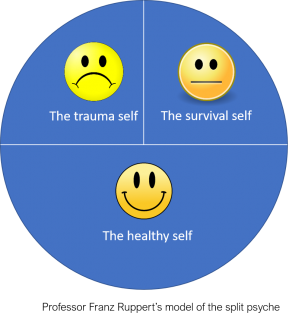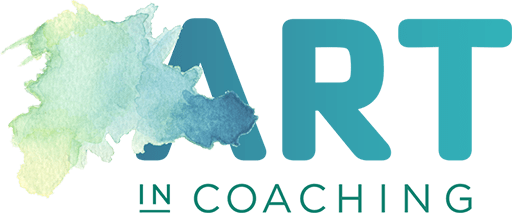
Trauma in the coaching space is not something I used to be aware of. However, my experiences over the years have shown me that it can be, and when it is, without me being aware of it, coaching can fail.
Reading and learning about trauma I am now aware that there are four ways that trauma may show up in my coaching:
- It may be the client presenting their survival self
- I become entangled with the client’s survival self
- My client shares past painful experiences and feelings with me, or
- The client experiences hyperarousal, a severe emotional response to a trigger.
Out of all of these it is the survival self that I mostly encounter.
The client’s survival self
Professor Franz Ruppert came up with a way of conceptualising trauma through the metaphor of split psyche. Ruppert says that as a person experiences trauma their psyche starts to split into three – the trauma self, the survival self and the healthy self.

The trauma self is the place in which the trauma feelings, experiences, memories and body memories are stored. They are locked away and very little, if any, can be accessed through cognitive recall.
The survival self is developed as part of the person’s trauma response. Julia Vaughan Smith summarises this as a complex combination of constructed identity and defence dynamics where all components are interactive, and it is very resourceful for providing defence and survival strategies. It has been developed and created to help the person cope with and get on in everyday life. Although not in a healthy way.
The healthy self is that part of a person’s psyche that is undamaged by the trauma and holds the person’s internal resources for a healthy life.
How much of each of these selves is present and how strong they are in an individual will vary depending on the extent of the trauma that they have experienced.
When the survival self is present
If the survival self is present it can show up in a number of different ways. The most common ones I have encountered are:
- Denial that there is a problem and the client believes they don’t need to do anything about it. For example, working long hours, not needing time for themselves and their wellbeing
- Rescuing others, especially around workload and performance management, to the detriment of themselves and possibly others
- Control over self and others which may show up in their behaviours at work and relationships. For example, not delegating as they need things to be done just so or know that it is being done ‘properly’, and this has become an habitual way of working
- Addiction shows up mainly as addicted to work but I am also alert to other forms of addiction
- Illusion where a client is not in touch with the reality of a situation. For example, not being able to ‘see’ a destructive professional or personal relationship for what it really is, or convinced that they can achieve something when that isn’t the case
The survival self is uncoachable
It is important to know that the survival self is not coachable. Julia Vaughan Smith describes the survival self as not being open to change and that it is usually active when the coaching goes wrong. Julia also states that the survival self is not coachable because it is inflexible, not open to self-reflection and inquiry, not receptive to feedback, out of contact with the body and is likely to harden its response if challenged. However, the survival self should always be respected, it is not a bad self.
Coaching works when the healthy self is present and one of our roles is to create the safe coaching space that allows our clients to connect to their healthy selves.
Becoming entangled with the client’s survival self
Entanglement is when a coach’s survival self becomes entangled with a client’s survival self. This happens when our trauma selves get triggered by what happens in the space (environmentally, verbally, behaviourally).
As coaches we need to do our own work on understanding and becoming aware of when our own survival selves may be present. I have started to do some work on this myself and was surprised to discover that I do have a survival self and it can show up in the coaching space (and other spaces!). For example, I will often bend over backwards to accommodate a client when they cancel or reschedule, moving or sacrificing things that are important to me to put them first. Another example is, for certain people, I may find myself not giving honest constructive feedback on how things are going between us, but rather offer polite responses even though I am pretty frustrated inside. Of course, now that I am more aware of these responses, I can challenge this in myself and do things differently.
Final thought
I hope this post has enabled you to start to see that it is really important that as coaches we understand if trauma is present in the coaching space. If it is, and we can recognise it, it allows us to respond appropriately and ensure that coaching offers a supportive, positive and constructive space for our clients.
If you want to find out more about how trauma may present itself in coaching, I highly recommend Julia Vaughan Smith’s book – Coaching and Trauma – from surviving to thriving. Or why not…
Join the masterclass… If you would like to explore further why not join Julia Vaughn Smith and me on the next Trauma and Art Based Coaching online masterclass
In my next blog I will start to explore the benefits of art-based coaching when trauma is present in our coaching.
Previous posts in the series:

3 comments on “Is trauma present? The survival self in coaching”